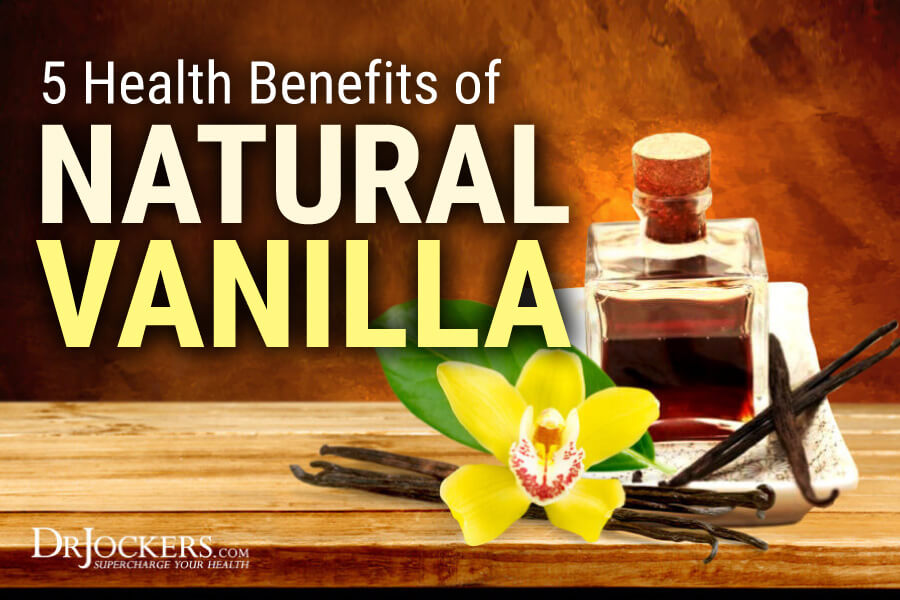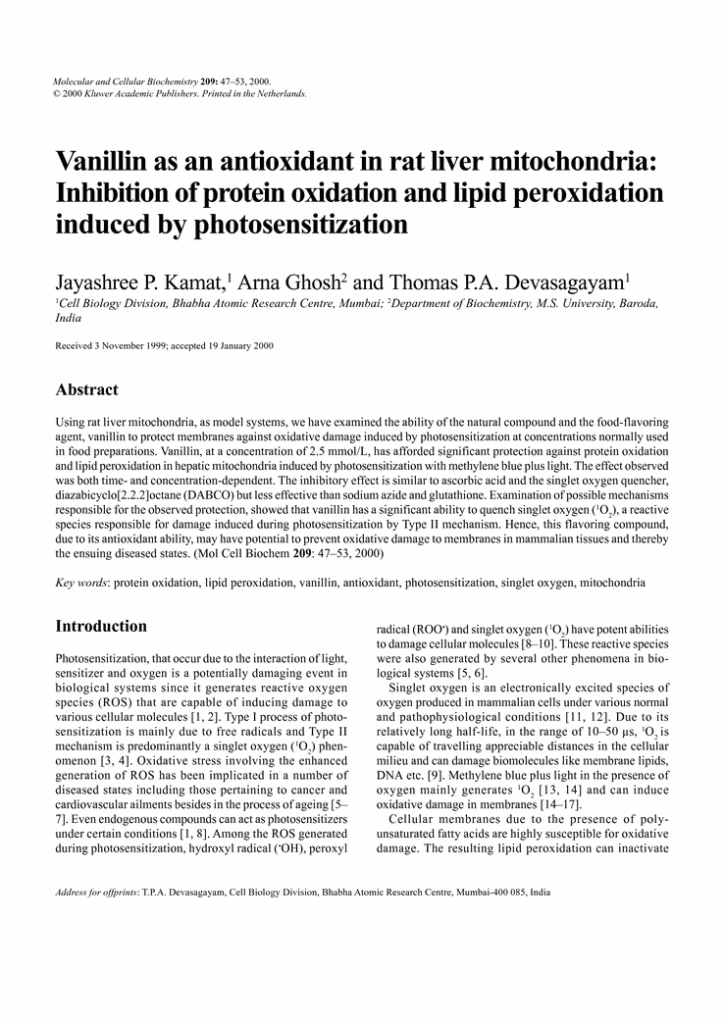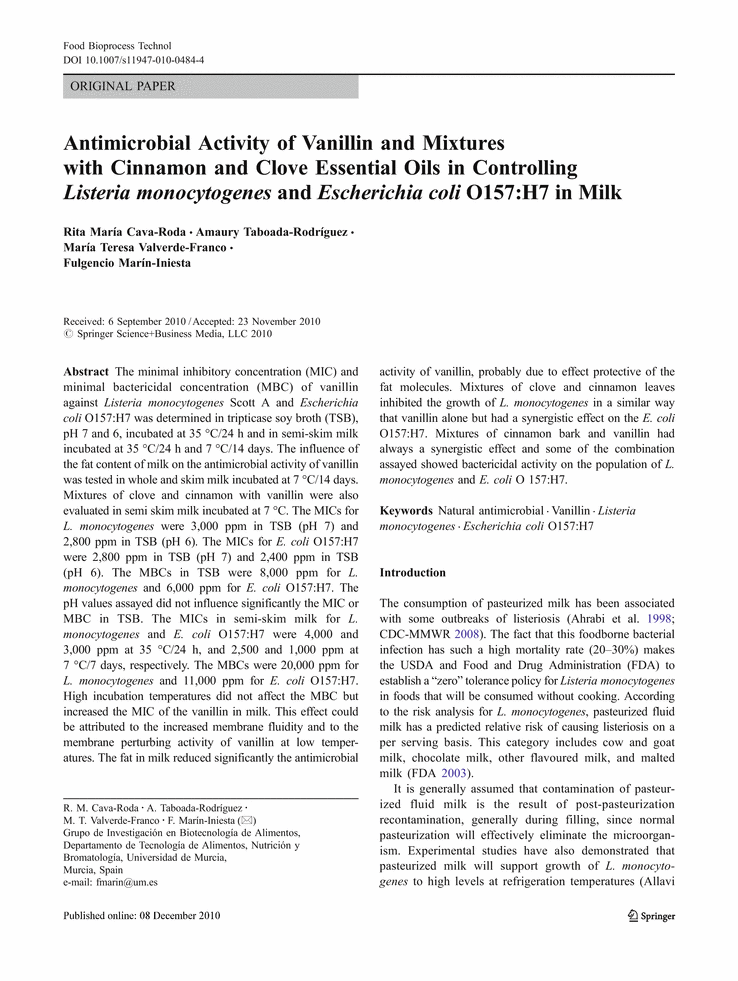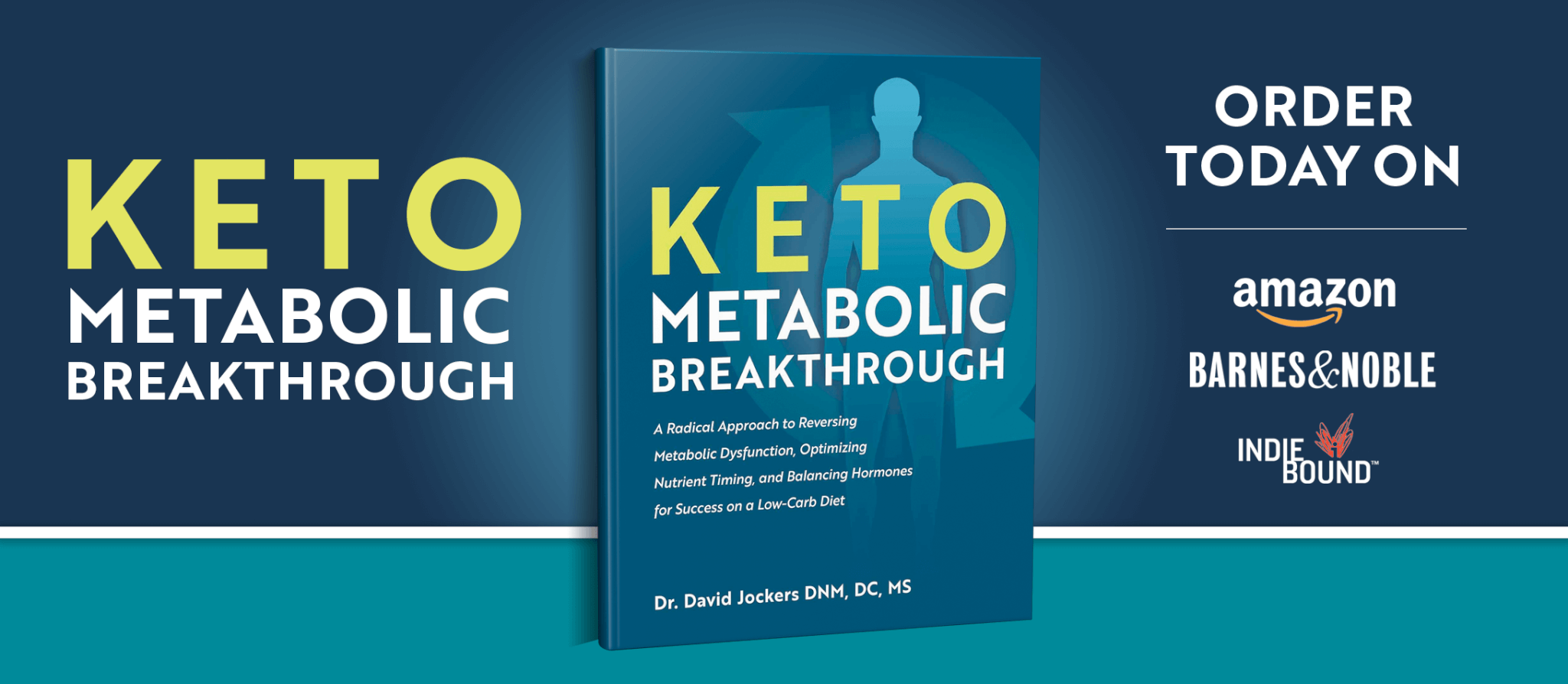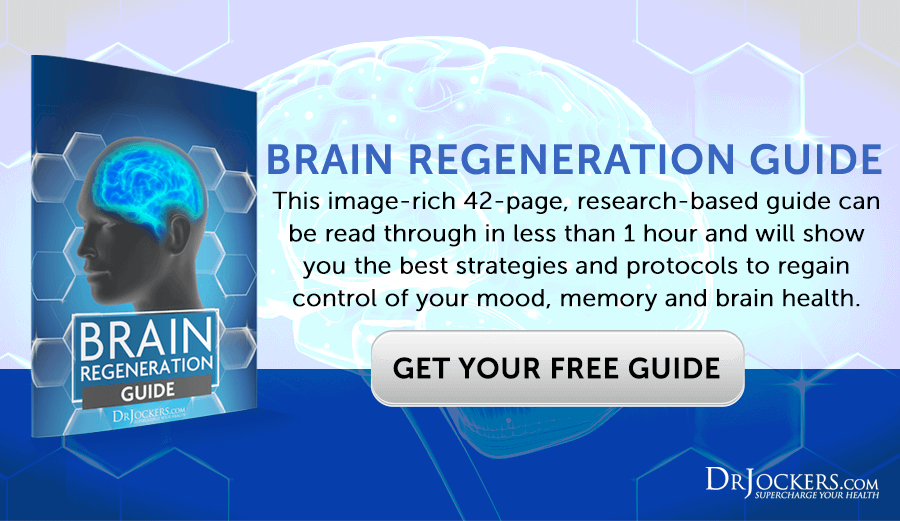5 Health Benefits of Natural Vanilla:
What first comes to mind when you think of the health benefits of vanilla? Do you immediately think of the soothing aromatherapy effects it triggers or perhaps the taste of black speckled vanilla bean ice-cream on a humid, sunny day?
Aromatherapists and psychologists alike have well understood the health benefits. Inhalation of a vanilla scent can help treat both mental and physical problems. The aroma alone has been shown to benefit human vitality by alleviating anxiety and supporting better sleeping habits, increasing libido, and stimulating an overall pleasurable emotion and peaceful feeling. (1)
The indulgent taste of vanilla has been shared for centuries but it is not it’s flavor or the aroma that elicits the best of its qualities. As the demand for natural products increasingly competes with pharmaceutical companies and the drug industry, scientists continually discover the benefits that vanilla has on human health. In fact, researchers support 5 major health reasons as to why you should incorporate vanilla into your lifestyle.
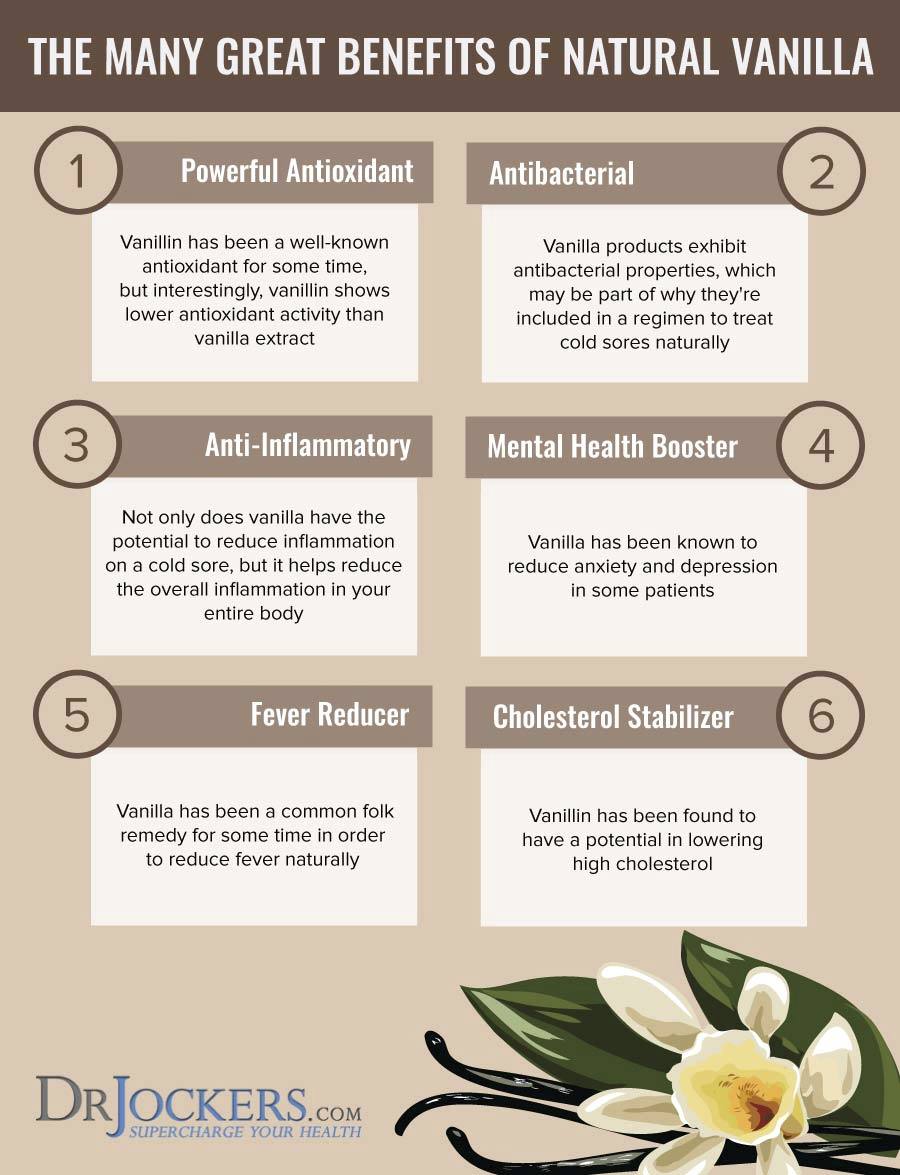
History of Vanilla
Vanilla is a worldwide popular ingredient that was historically used by the Aztecs to make a cocoa drink that only the kings were privileged to consume. Later in 1575, vanilla would be exported with gold to Spain and now it remains one of the most expensive spices in the world only second to saffron (1).
Thomas Jefferson was so intrigued with its taste in ice-cream while living in Paris that he copied down a recipe and brought it back home with him to the United States (2).
The Vanilla Bean
The vanilla bean is an edible fruit pod that resembles a string bean when harvested. The result of a curing process produces a dark vanilla bean with a rich aromatic fragrance. The vanilla seeds that look like caviar can be scraped out from inside the fruit pod and hence your black speckled ice-cream.
Unfortunately, because the bean is so costly to produce, over 90% of vanilla products in the marketplace are artificially manufactured (1, 2).
Uses for Vanilla
The fragrance of vanilla is considered an aphrodisiac and is therefore commonly used by the perfume industry in male colognes to boost libido (1). It is also used for other common purposes as you are likely aware. The obvious places you may find vanilla are baked goods, beverages such as the famous Coca-Cola, yogurt, and candles. It also lurks in the ingredient list of tobacco products and pharmaceutical drugs (5).
Why would pharmaceutical companies use the active components of vanilla to manufacture drugs you ask? Be assured that the reason is not to increase someone’s desire to take a pill as if it were candy. In fact, the five major health benefits that it offers include its ability to act as an antioxidant, an antimicrobial, inhibits cell mutations, exhibits analgesic properties and suppresses the formation of new blood vessels involved in cancer metastasis.
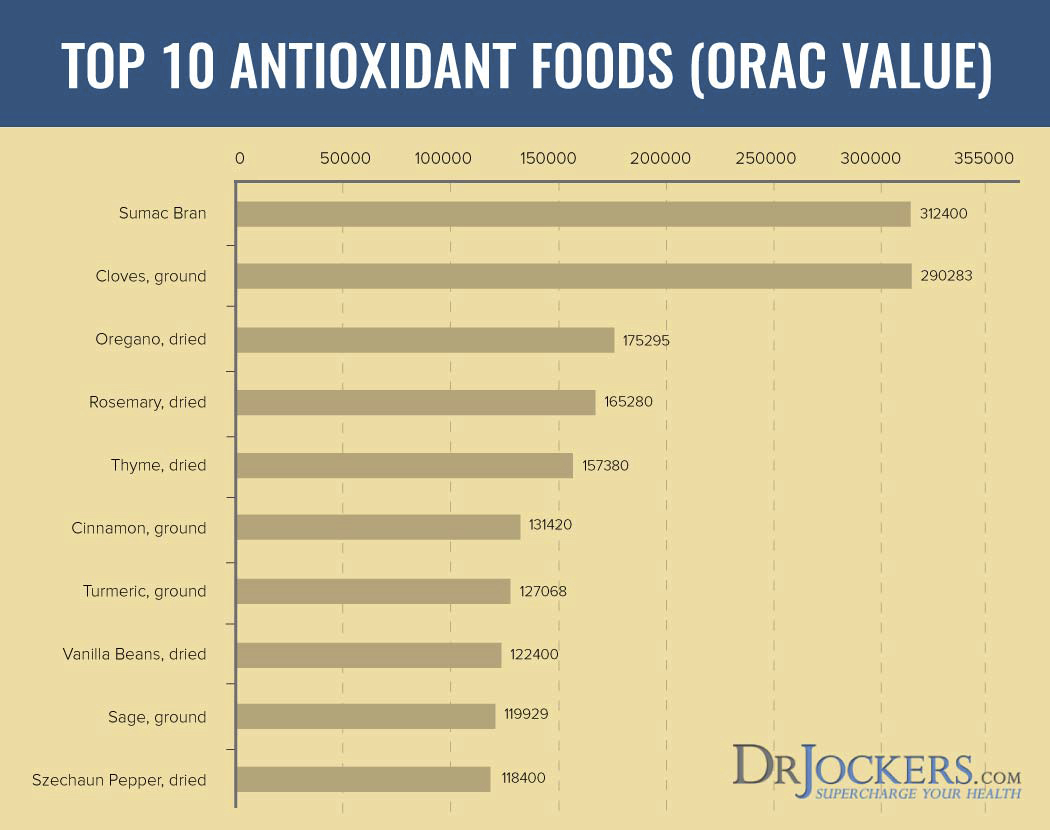
Health Reason #1: Antioxidant Capabilities
Vanilla contains over 250 different chemical compounds that provide flavor and fragrance to the spice (2). Found in different concentrations depending on where the vanilla bean was cultivated, vanillin is dominant.
Researchers have identified vanillin as a nutraceutical with antioxidant capabilities (4). Nutraceuticals are sources in food used in alternative medicine to prevent or treat disease.
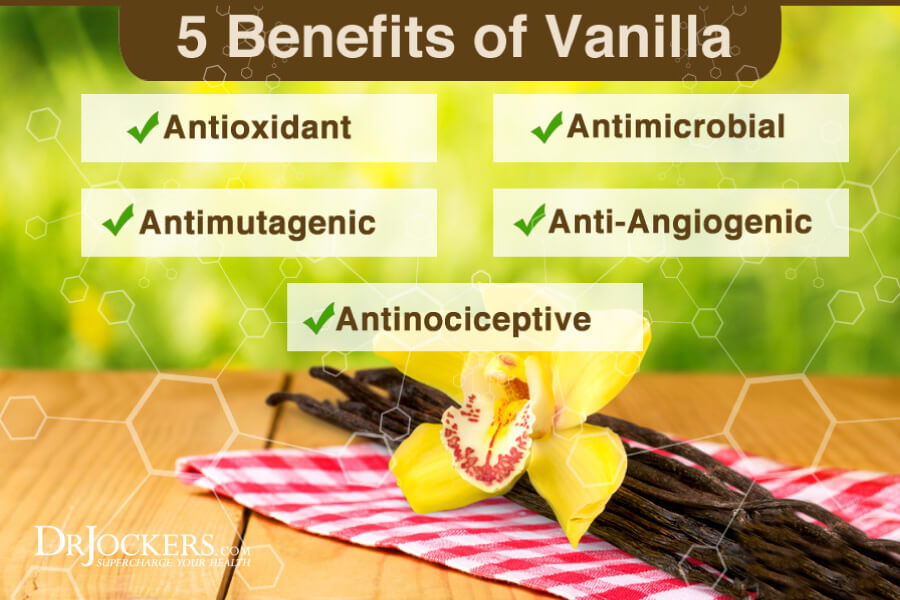
Vanillin
Antioxidants are an immediate defense line against destructive free radicals which interact with and damage cells. At standard levels in which one might add pure vanilla extract in recipes, the vanillin concentration is sufficient enough to protect against oxidation and lipid peroxidation. Coupled together, the two processes result in free radical damage that causes inflammation in the body and potentially cancer. (4, 5, 10)
Repeated studies support vanillin’s ability to scavenge and bind to free radicals and drastically reduce their numbers. Although other chemical components of pure vanilla exhibit antioxidant activity, vanillin is the most researched to date.
One study has shown that heating vanilla has additional benefits. Just as the concentration of vanillin increases throughout the curing process of the bean, heating it alters the antioxidant properties. Heat induces the transformation of vanillin into vanillic acid which has been studied as an effective antimicrobial agent. (5)
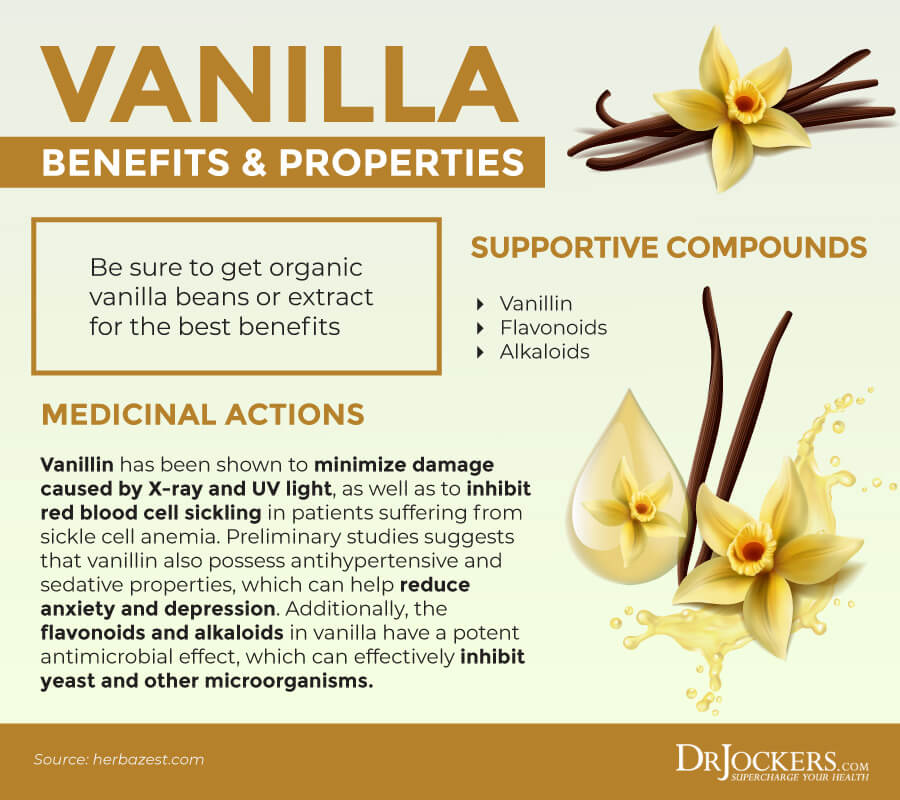
Pharmaceutical Use: Hydrazones
Pharmaceutical companies use pure vanillin in the production of hydrazones in drugs (5). Hydrazones are compounds that possess biological activities.
Combined with the antioxidant properties of vanillin, pharmaceutical teams design different hydrazones to administer to individuals who suffer from depression, epilepsy, and chronic arthritic conditions such as rheumatoid arthritis for example (13).
Health Reason #2: Antimicrobial
As mentioned, another functional property of vanilla is its antimicrobial activity. Vanillic acid has been shown to protect the body against bacteria, mold and yeast. For these reasons vanilla is a popular ingredient in herbicides to prevent against disease ridden crops. (5)
Combined with cinnamon, the vanillin component of vanilla has a synergistic effect at inhibiting bacteria such as Salmonella, L. monocystogenes and E. coli. These bacteria can be contaminants in food that cause digestive upset, fatigue, muscle aches and more serious symptoms such as convulsions and disease. (7, 10)
The combination of vanillin and cinnamon has a powerful ability to significantly reduce the concentration of harmful bacteria and inhibit its ability to reproduce effectively. Next time you indulge on a sweetened hot cocoa treat, add a splash of vanilla and sprinkle in cinnamon for an additional health perk.
Pharmaceutical Use: Prescription Drugs
As a result of vanilla’s antimicrobial properties, drug manufacturers incorporate these effective compounds such as vanillin into prescription drugs. For instance, trimethoprim is an antibacterial drug manufactured to treat urinary tract infections (UTIs).
If you are prone to UTIs, isn’t it worth it to you to learn if the addition of this into your diet decreases the frequency or may event prevent the occurrence of the problem? (5)
Health Reason #3: Antimutagenic Activity
Intimately correlated with the ability of vanilla to act as an effective antimicrobial, vanillin has been shown to reduce the rate of mutations in cells or act as an antimutagenic agent (10). Think of the Teenage Mutant Ninja Turtles for example. They mutated from small baby turtles into adult sized beings after crawling through ooze with obvious mutagenic effects.
What is a Mutagenic Agent?
The human body is frequently exposed to mutagenic agents. Although mutated turtles turned human sized in reality would probably cause anyone to avoid the very source that triggered the mutation, our habits as a general species seems to convey that such a mutation would be the least of our worries. After all, we know that our bodies are harmed by the many factors that we involve ourselves in daily yet we don’t seemed as concerned with those potentially life devastating effects.
Carcinogenic chemicals from cigarette smoke, plastic, pesticide residue on foods, and even molds induce mutations in our cells by causing DNA damage. We also expose our bodies to physical mutagens such as UV-light and radiation. Essentially, we are welcoming mutagenic activity into our cells which cause disease and cancer. Perhaps you might actually prefer the life sized turtle.
Vanillin: A Biological Antimutagen
Vanillin was found in one study to affect 64 genes known to cause DNA damage, stress and oxidative damage, apoptosis (“cellular suicide”), and cell proliferation. Vanillin is involved in DNA replication and repair which inhibits mutagenic activity. It is therefore classified as a biological antimutagen for its ability to prevent harmful mutations. (5, 10)
One reason why colon cells are highly susceptible to cancer today and is increasingly prevalent is a result of the high turnover rate of colon cells. The higher the speed and frequency in which new cells are replacing old ones, the greater the opportunity for a mutation to occur.
Vanillin has reduced the frequency of mutations in colon cells by 64%. Consequentially, vanillin has also increased the number of genes responsible for the production of a highly effective antioxidant found in cells, glutathione. (10)
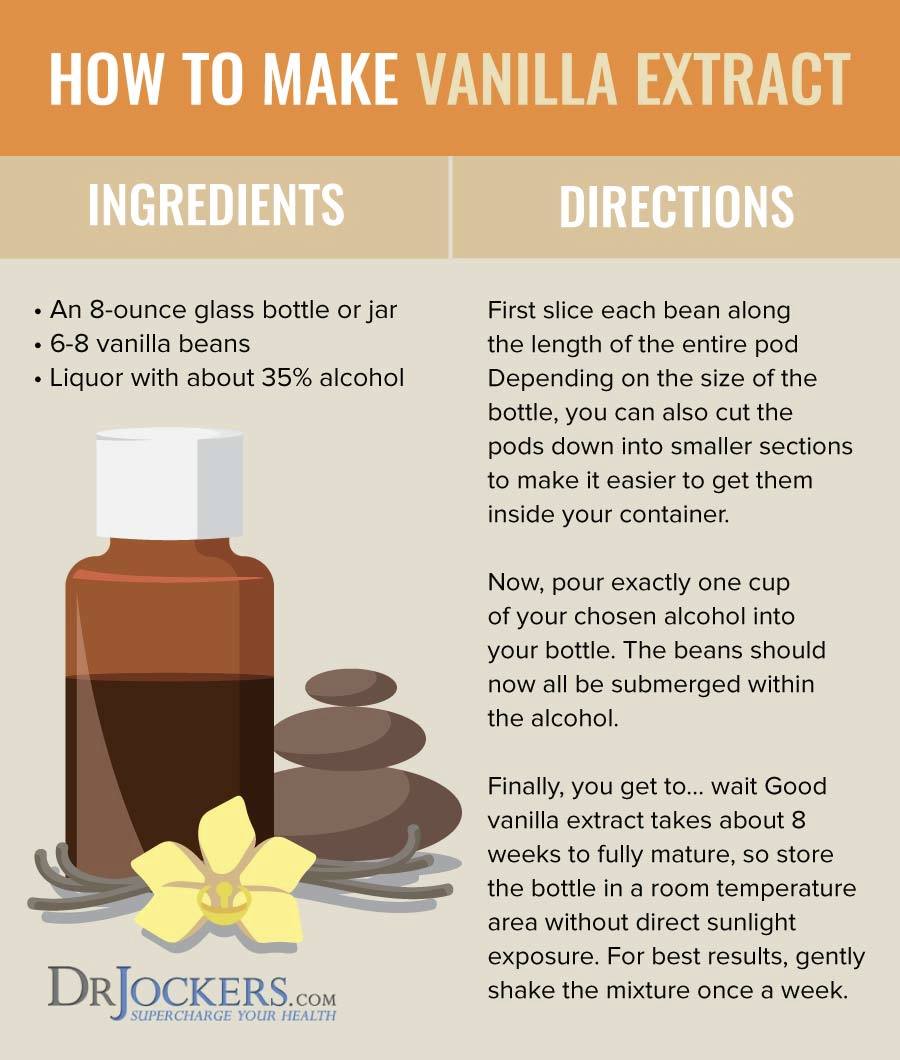
Health Reason #4: Anti-Angiogenic Activity
Vanilla also contains properties that enable the body to inhibit angiogenesis. Angiogenesis is the formation of new blood vessels and is also the weapon of choice that cancer cells use in their aggressive spread throughout the body. The description new might have you think this occurrence is a good thing but tumors feed off of the blood supply for nutrients and oxygen.
Cancer Prevention
Vanilla may decrease the rate at which cancer can spread or may even prevent its occurrence. With the incidence rates of cancer on the rise, much research has demanded the attention of any possible anti-angiogenic agent.
Researchers have learned that vanilla can suppress an enzyme crucial in the metabolic pathway of promoting the spread of cancer cells (5). Scientists have also found that ethyl vanillin, another aromatic compound found in the beans, is a natural inhibitor for angiogenesis (8). How exactly it achieves this goal is just recently being understood.
Nitric oxide is a molecule used in various reactions in the body and also plays a role in cancer development. Ethyl vanillin inhibits the production of nitric oxide in tumor cells. As a result, tumors cannot grow because of a lack of an oxygen supply. (8)
Ethyl vanillin has also been linked to suppressing the activity of a destructive enzyme. This enzyme has been studied for its invasive behavior and role associated with kidney damage and disease such as lupus nephritis and diabetic nephropathy. The ethyl vanillin contained in this therefore shows promising results by preventing the spread of cancer in the kidneys, liver and even lungs. (9)

Health Reason #5: Pain Relieving Properties
The various components of vanilla have long been studied for its antinociceptive properties. In other words, it helps to desensitize an individual’s perception of pain. Have you ever been told: it’s all in your head?
That is because pain is in your head, specifically in your brain, and involves the interaction of both physiological and psychological factors (11).
Vanilla Stimulates Your Sense of Smell
Why do aromatherapists and psychologists combine the inhalation of vanilla into their practices? Active compounds in it stimulate your sense of smell.
Inhalation of these compounds reaches the bloodstream through the lungs as well as the emotion center of the brain following a complex network of nerves. As a result, the aromatic powers of vanilla stimulate the release of hormones and neurochemicals which promote mental health and an emotional response. (1)
Vanilla is such an effective aroma at promoting health that one study reported cancer patients had 63% less anxiety while undergoing a stressful diagnostic procedure. A study out of Germany suggests that the aroma of it decreases an individual’s startle-reflex response by triggering a calming emotion. (12)
Memory also arouses emotional effects. Think of the smell of vanilla in grandma’s apple cobbler crumb topping with a scoop of vanilla bean ice cream. Did this image cause the recollection of positive feelings of warmth and comfort?
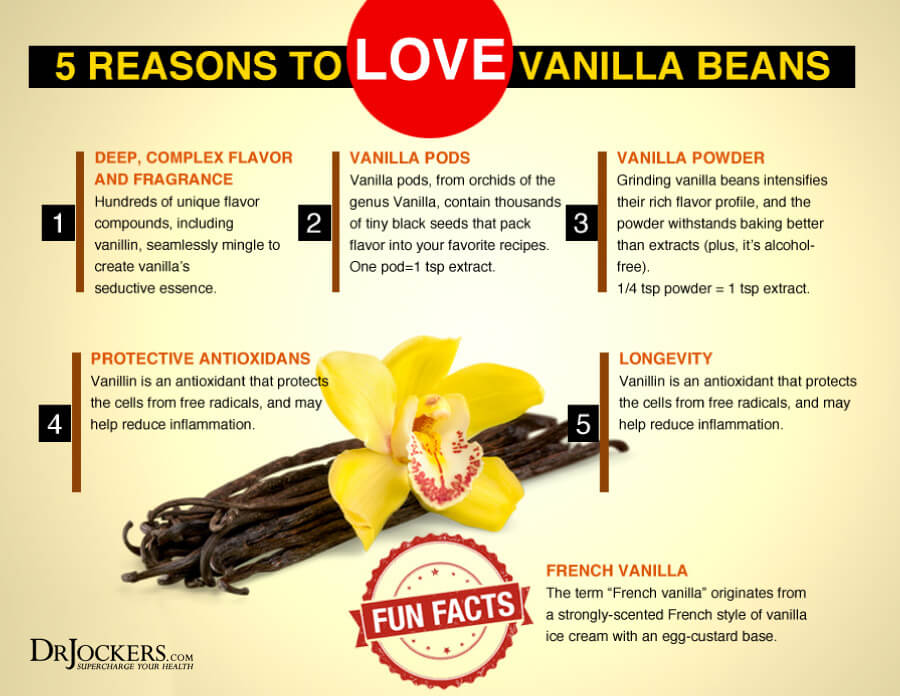
Incorporate Vanilla into Your Lifestyle
Here are a few tips at incorporating vanilla into your lifestyle so that you may take advantage of its powerfully healthy components.
- Enjoy both cooking and baking with pure vanilla extract in your favorite recipes – Think hot cocoa, breakfast smoothies, carrot cake, or sweet addition into your bulletproof coffee in the morning
- Use vanilla aromatherapy in your bath by including oils and candles (just try to shoot for 100% beeswax candles to avoid added carcinogens into your home and body)
Maybe you are already the “Plain Jane” who incorporates vanilla into your lifestyle without having been aware of its benefits. But either if you are or are now planning to do so, do you know how to make sure you are receiving the benefits from pure vanilla?
Tips for Purchasing Vanilla Products
As with most other products of high demand and intensive labor costs, there will be synthetic products on the market trying to mask their true identity. Chemically produced vanilla contains higher concentrations of impurities and contaminants (5). When purchasing vanilla products, utilize the following tips in your search for pure and naturally sourced vanilla: (3, 6)
- Fortunately, the United States Food and Drug Administration (FDA) does specify the concentration of the bean that must be present in vanilla extract. The United States also has banned courmarin which can be contained in some vanilla extract products. Look for the FDA approved seal on the bottle to avoid the toxic side effects of coumarin. Especially avoid “tonka bean” or other ambiguous ingredients labeled;
- Unfortunately, the FDA also permits added ingredients such as glycerin, propylene glycol, sugar, dextrose and corn syrup which can harm health. Look for pure vanilla extract that contains only “vanilla_bean” for maximized health rewards.
- Avoid labels not written in English. Especially avoid purchasing the extract at ethnic food stores at cheap prices. Remember, the vanilla bean is expensive to harvest. If it is a great price to you, how is the producer benefiting? Put it back on the shelf.
- Scrape out the thousands of seeds from a bean for a unique experience and create your own homemade vanilla extract using the remaining bean pods.
- Do not think for a moment that you are getting health benefits from vanilla flavored vodka, wafers or other manufactured foods. “Vanilla-like” flavorings do not meet the quality requirements of foods containing vanilla by the FDA.
- Remain skeptical of products sourced from genetically modified vanilla. Manufacturers are currently seeking ways to genetically engineer the vanilla bean to produce a higher crop yield.
How Will Vanilla Benefit You
There are many reasons why vanilla can improve your overall health and vitality. Whether you are looking for a new way to sweeten foods or your mood, this is an excellent option. Will you start adding vanilla into your lifestyle?
Sources For This Article Include:
1. Rose, J. The Aromatherapy Book: Applications & Inhalations. North Atlantic Books. 1992. 1-373. Link Here
2. National Geographic: The History of Vanilla_Link Here
3. S. Food and Drug Administration: Some “Vanilla_Extract” Produced in Mexico is No Bargain Link Here
4. Shyamala BN, et al. Studies on the Antioxidant Activities of Natural_Vanilla Extract and Its Constituent Compounds through in vitro J Agric. Food Chem. 2007 Aug;55(19):7738-7743. PMID: 17715988
5. Guzman CC, and Zara RR. Handbook of Herbs and Spices. Woodhead Publishing Limited. 2012 Jan;2(1):547-589. Online ISBN: 978-0-85709-567-1
6. GDA: Code of Federal Regulations Title 21 Link Here
7. Cava-Roda RM, et al. Antimicrobial Activity of Vanillin and Mixtures with Cinnamon and Clove Essential Oils in Controlling Listeria monocytogenes and Escherichia coli O157:H7 in milk. Food and Bioprocess Tech. 2012 Aug;5(6):2120-2131. DOI: 1007/s11947-010-0484-4
8. Jung HJ, et al. Assessment of the anti-angiogenic, anti-inflammatory and antinociceptive properties of ethyl vanillin. Archives of Pharm. Res. 2010 Feb;33(2):303-316. DOI: 1007/s12272-010-0217-2
9. Urushihara M, et al. Glomerular distribution and gelatinolytic activity of matrix metalloproteinases in human glomerulonephritis. Nephrol. Dial. Transplant. 2002;17(7):1189-1196. DOI: 1093/ndt/17.7.1189
10. King AA, et al. Antimutagenicity of cinnamaldehyde and vanillin in human cells: Global gene expression and possible role of DNA damage and repair. Mut. Res./Fund. Mol. Mech. Mutag. 2007 Mar;616(1-2):60-69. PMID: 17178418
11. Bingel U, et al. Habituation to painful stimulation involves the antinociceptive system. Pain. 2007 Sep;131(1-2):21-30. PMID: 17258858
12. Social Issues Research Centre: The Smell Report “Vanilla” Link Here
13. Rollas S, and Kucukguzel SG. Biological Activities of Hydrazone Derivatives. Molecules. 2007;12(8):1910-1939. DOI: 3390/12081910
